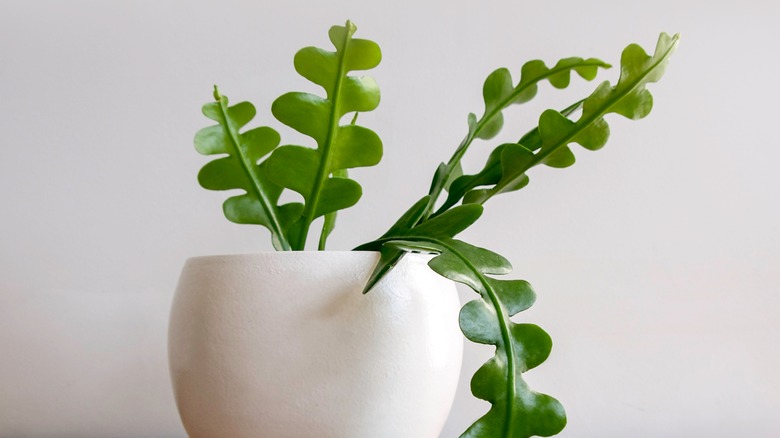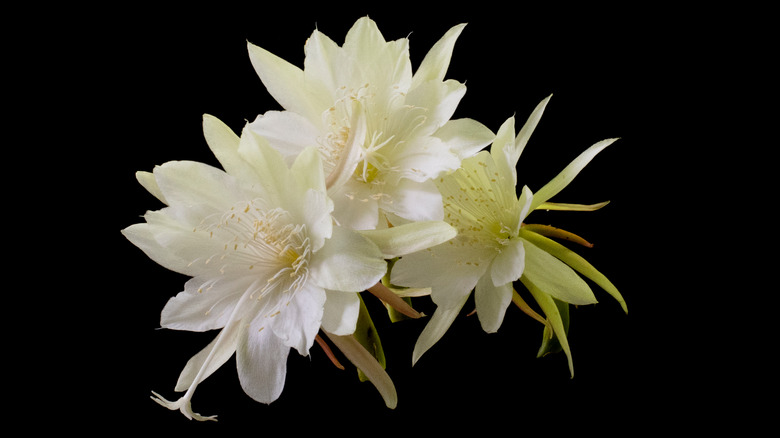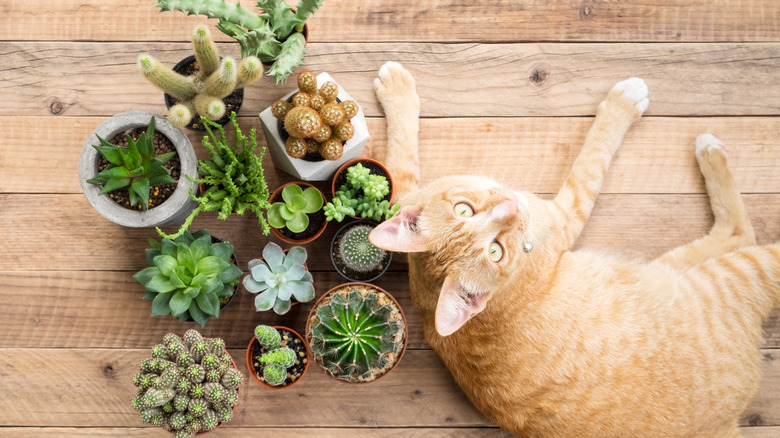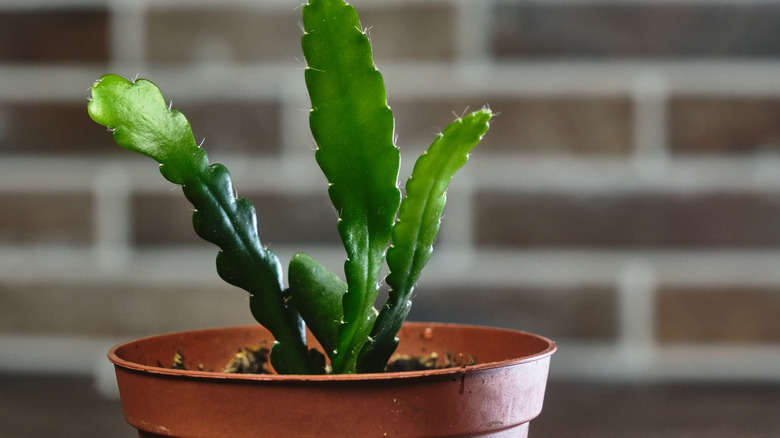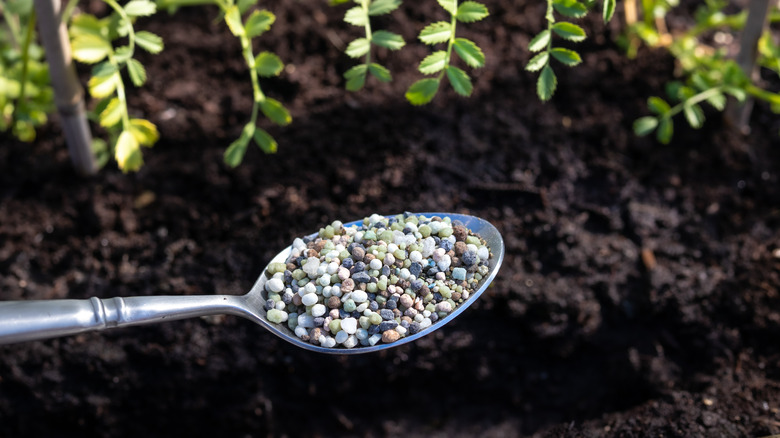How To Care For A Zig Zag Cactus
Disocactus anguliger, most commonly called the zig zag or fishbone cactus, is an epiphytic cactus originally found in Mexico. Gardening Solutions by University of Florida explains that an epiphyte is a plant that attaches itself to the side of a host tree for support but will not behave like a parasite. Instead, an epiphyte can derive all of its necessary nutrients from the sun and the air around it, making this a dream option for beginner gardeners. As for the nicknames zig zag and fishbone, those refer to the jagged shapes their stems grow into, which have a toothy look similar to the spine of a deboned fish.
Other names for the zig zag include ricrac and orchid cactus. According to The Spruce, the fact that it is a tropical plant makes it an excellent option for those who have had trouble keeping a desert cactus happy and healthy. Unlike its dry heat-loving cousins, the zig zag cactus thrives in high humidity and even does well in a spot with indirect light. It is important to note that the this cactus is entirely different from the zig zag plant, which is more often known as Devil's Backbone.
How to grow zig zag cactus
Being classified as epiphytic means the zig zag cactus can grow without soil, but that doesn't mean it has to. These plants will appreciate an appropriate potting soil mix just as much as your other houseplants. For this disocactus, go with either orchid or cactus-specific soil, which will be purposefully porous for the best aeration and drainage. Place your plant somewhere bright but keep direct sunlight to a minimum. Water after the soil has completely dried.
To propagate a zig zag, all you have to do is cut off a piece of stem and leave it untouched for a couple of days so it can harden. Once you see a callus forming around the cut tip, you can press that side down into a new pot with fresh soil. Gardening Know How suggests a sphagnum peat moss mixture for these new starters. Water and repeat the process as often as you'd like.
How to care for zig zag cactus
House plant enthusiasts love the zig zag cactus because it is so easy to care for. And if you're still working on strengthening your green thumb, this is a great low-maintenance plant option that will add a unique architectural flair to your space and could make you look like an interior design pro. Your cactus will thrive in its original pot so long as you find it a home with plenty of indirect sunlight and water only when necessary. Really let the soil dry out before giving your cactus its next thorough soak.
Patient zig zag owners may get to see stunning white flowers blooming, but be prepared to wait a few years for these beauties to appear. Per The Spruce, cold temperature exposure will be necessary to make this happen. But again, be patient. A zig zag that experiences a cool winter and spring still won't blossom until late in the summer, if at all. In truth, it's no easy feat to get this cactus to bloom. Don't give up if you don't get any flowers, even by its third or fourth season. You're most likely not doing anything wrong; this is just a quirky and very unpredictable plant when it comes to flowering.
Is the zig zag cactus toxic?
A great thing about the zig zag cactus is that it is nontoxic to humans and pets, including cats, dogs, and horses. This makes it a safe addition to your houseplant repertoire that can be placed anywhere in your home. Resident veterinarian Dr. Justine A. Lee, DVM, DACVECC from Pet Health Network, explains that cats are carnivores, and it's rare for them to consume large quantities of plants. So there is no need to worry if your curious feline takes a tiny nibble here and there; your pet probably just wants to chew on something different for a change.
However, as with all houseplants, if your cat or dog consumes an unexpectedly generous amount of your zig zag cactus, you may want to take extra care. Dr. Lee reminds us that excessive consumption of even a nontoxic plant could result in gastrointestinal stress. Common symptoms include stomach upset and possible vomiting. If you have any questions or concerns at all, don't hesitate to call your local vet or the ASPCA Animal Poison Control Center, as recommended.
How to repot your zig zag cactus
More often than not, zig zag cacti are used indoors as houseplants; since direct sunlight can damage their stems and won't survive the very cold months, these plants fare better in a protected environment. Another factor that makes this an easy-care option is that they don't need to be repotted more than once every two years. According to HOUSEPLANTHOUSE, even zig zags that grow large will still have a small root system and can therefore stay comfortable in a small pot longer.
When the time comes, repotting is a cinch and should take only a few minutes. Follow the standard rule of choosing a new pot that is only one size bigger than the original. Fill your new pot about 1/3 of the way to the top with a well-draining orchid or cactus potting soil mix. Brace the base of your plant, tip the pot over and give the bottom a tap. Gently move the rootball to its new pot home and backfill any holes with more soil. A touch of water will do the trick, and you're all done. Zig zags are also an excellent option for hanging baskets as their stems will grow long and trail over. Or consider placing it on an elevated shelf.
How to fertilize a zig zag cactus
You can fertilize your zig zag plant about once every two months throughout the growing season, which will start in early spring and run until late summer. It is not necessary to fertilize your cactus during the winter; you can also cut back on food anytime you want to slow your plant's growth down. You can get by with the basic granular option available at your local garden center for general use.
Remember those absolutely gorgeous yet tricky-to-produce flower blooms mentioned earlier? Well, if you're looking for ways to promote their growth, a pro tip from Savvy Gardening to get the life back in a stalled cactus is to use a fertilizer that is higher in potassium. Potassium has been shown to increase bloom quantity and size by activating the enzymes that ignite protein and sugar production. An orchid or African violet-specific fertilizer may do the trick; another option is to try adding tomato fertilizer to your regular routine during those warmer months.
